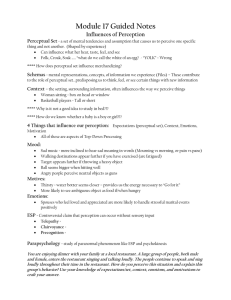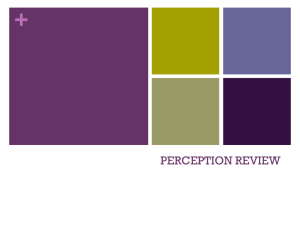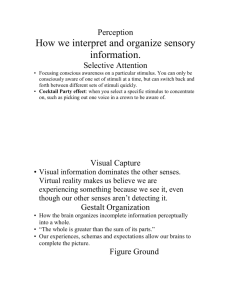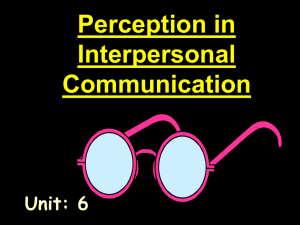Psychology (8th Edition) – David Myers Chapter 6 – Perception (pg
advertisement
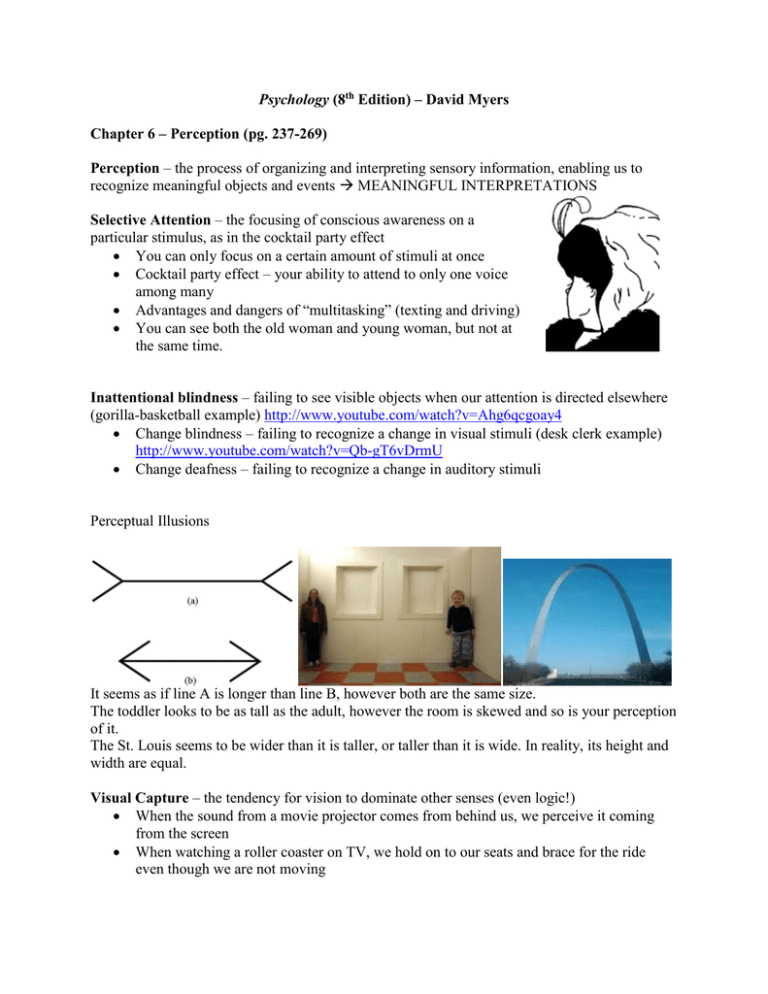
Psychology (8th Edition) – David Myers Chapter 6 – Perception (pg. 237-269) Perception – the process of organizing and interpreting sensory information, enabling us to recognize meaningful objects and events MEANINGFUL INTERPRETATIONS Selective Attention – the focusing of conscious awareness on a particular stimulus, as in the cocktail party effect You can only focus on a certain amount of stimuli at once Cocktail party effect – your ability to attend to only one voice among many Advantages and dangers of “multitasking” (texting and driving) You can see both the old woman and young woman, but not at the same time. Inattentional blindness – failing to see visible objects when our attention is directed elsewhere (gorilla-basketball example) http://www.youtube.com/watch?v=Ahg6qcgoay4 Change blindness – failing to recognize a change in visual stimuli (desk clerk example) http://www.youtube.com/watch?v=Qb-gT6vDrmU Change deafness – failing to recognize a change in auditory stimuli Perceptual Illusions It seems as if line A is longer than line B, however both are the same size. The toddler looks to be as tall as the adult, however the room is skewed and so is your perception of it. The St. Louis seems to be wider than it is taller, or taller than it is wide. In reality, its height and width are equal. Visual Capture – the tendency for vision to dominate other senses (even logic!) When the sound from a movie projector comes from behind us, we perceive it coming from the screen When watching a roller coaster on TV, we hold on to our seats and brace for the ride even though we are not moving Perceptual Organization To form sensory input into meaningful perceptions, we must ORGANIZE it o Distinct from surroundings o Have meaning and constant form o Discern distance and motion Gestalt – an organized whole o German psychologists found that when people are exposed to a cluster of sensations, they automatically try to organize them into a whole o Gestalt psychology – emphasizes our tendency to integrate piece of information intro meaningful wholes. o The brain automatically perceives the 8 red circles with white lines as a cube making a whole from pieces Form Perception o Recognizing objects as distinct from their background – figure-ground relationship – the organization of the visual field into objects (figures) that stand out from their surroundings (ground) o Whatever you are paying attention to (visual, auditory, touch stimulus) becomes the figure, and everything else is the background o The words you are reading right now are the figure while the white paper is the background. o Optical illusions can distort this as seen to the right. o Now recognizing the figure, we need to organize it into a meaningful form. o Grouping – the tendency to organize stimuli into coherent groups Proximity – grouping nearby figures Similarity – grouping similar figures Continuity – group smooth continuous patterns rather than discontinuous ones Connectedness – grouping uniform and linked figures Closure – we fill in gaps to create a whole o Usually these principles help us, but can make us victim to perceptual illusions Depth Perception – seeing objects in three dimensions; allows us to judge distance o Is depth perception innate? o Visual cliff – a lab device for testing depth perception in infants and young animals o Gibson and Walk developed the visual cliff to see when babies and animals developed depth perception o Found that babies who can crawl have a somewhat developed sense of depth perception (part of learning how to crawl and navigate the world) and newborn animals were also reluctant to go over the cliff. Binocular Cues – depth cues that rely on the use of both eyes o Eyes are about 2.5 inches apart retinas receives slightly different visual information o By comparing the retinal disparity between the two eye images, depth cues can be made o Retinal disparity – a binocular cue for perceiving depth; the brain compares the images from the two eyeballs and computes the difference - the greater the disparity between images, the closer the object. o Convergence – a binocular cue for perceiving depth; the extent to which the eyes converge inward when looking at an object – the greater the strain, the closer the object. Monocular Cues – depth cues that are available to each eye separately o Relative size – for objects that are the same size in reality, the one that appears smaller is farther away o Interposition – if one object partially blocks the view of another, the first object is closer o Relative clarity – hazy/dim objects are farther away than sharp, clear objects o Texture gradient – coarse, distinct texture signals far away images, while fine, indistinct texture signals increasing distance (objects farther away appear smaller and less densely packed) o Relative height – objects higher in the vision field are farther away o Relative motion – as objects are moving, you focus on a fixation point… objects beyond the fixation point move with you, while those nearest to you seem to move faster o Linear perspective – parallel lines seem to converge with distance o Light and shadow – given two objects, the dimmer one seems farther away; shading produces a sense of depth; we assume all light comes from above. Motion Perception Shrinking objects are doing away from us Enlarging objects are approaching us Quick successions of images across the retina can be perceived as movement o Phi phenomenon – an illusion of movement when two or more adjacent lights blink on and off in quick succession Perceptual Constancy – the ability to perceive objects as unchanging even as illumination and retinal images change (we can identify things even if their color, illumination, or angle change) Shape constancy – we perceive the form of an object as constant even though the shape of it changes (ex: we know doors are rectangles, however when they open towards us they appear to be trapezoidal, but we know the shape is still the same) Size constancy – we perceive objects as having constant size even though our distance from them changes o Size distance relationships – given an object’s perceived distance and the size of its image on our retinas, we instantly and unconsciously infer the object’s size. In the picture to the right, the room is distorted with the right side being significantly closer to the observer. Because the room looks normal and makes sense to our brain, our brain assumes that they are both the same distance away. Lightness constancy – we perceive an object as having a constant lightness even while its illumination varies – the brain perceives the lightness quality relative to surrounding objects Sensory Deprivation and Restored Vision Studies show people born blind but later gained sight could not visually recognize objects that were familiar by touch. There is a critical period for normal sensory and perceptual development – visual stimulation is required during infancy to allow for shape and object recognition Perceptual Adaptation – in vision, the ability to adjust to an artificially displaced or even inverted visual field When people are given glasses that distort the world, they are initially disoriented, but soon adapt to the new context and can navigate it with ease. We coordinate our movements in response to our environment (or perceived environment) Perceptual Set – a mental predisposition to perceive one thing and not another. Experiences, expectations, and assumptions result in the formation of concepts/schemas to organize and interpret information which then dictate what we perceive We see what we believe/want/think we see. Mary had a a little lamb did you read that as “Mary had a little lamb” or “Mary had a a little lamb” … we perceive what we expect. Context Effects Perception of the same stimuli can differ depending on the context in which we experience the sensation. o “eel is on the wagon” – you might have perceived “wheel is on the wagon” o “eel is on the orange” – you might have perceived “peel is on the orange” Perception as biopsychosocial phenomenon Biological influences o Entry-level sensory analysis o Unlearned visual phenomena o Critical period for sensory development Psychological influences o Selective attention o Learned schemas o Gestalt principles o Emotional context effects o Perceptual set Social-cultural influences o Cultural assumptions and expectations o Physical context effects Perception and the Human Factor Human factor psychology – a branch of psychology that explores how people and machines interact and how machines and physical environments can be made safe and easy to use. o Help design products and appliances that make perceptual sense and are easy to use Is There Extrasensory Perception? Extrasensory perception (ESP) – the controversial claim that perception can occur apart from sensory input; said to include telepathy, clairvoyance, and precognition Parapsychology – the study of paranormal phenomena, including ESP and psychokinesis o Psychokinesis – mind over matter: levitating, controlling things with the mind o ESP Telepathy – mind to mind communication Clairvoyance – perceiving remote events Precognition – perceiving future events Parapsycholoy cannot gain scientific credit because it cannot reproduce its results.

